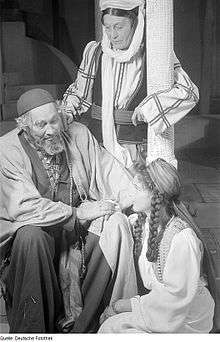Paul Wegener
| Paul Wegener | |
|---|---|
 Paul Wegener | |
| Born |
11 December 1874 Arnoldsdorf, West Prussia, Imperial Germany |
| Died |
13 September 1948 (aged 73) Berlin, Germany |
| Occupation | Actor |
Paul Wegener (11 December 1874 – 13 September 1948) was a German actor, writer and film director known for his pioneering role in German expressionist cinema.
Stage and early film career
At the age of 20, Wegener decided to end his law studies and concentrate on acting, touring the provinces before joining Max Reinhardt's acting troupe in 1906. In 1912, he turned to the new medium of motion pictures and appeared in the 1913 version of The Student of Prague. It was while making this film that he first heard the old Jewish legend of the Golem and proceeded to adapt the story to film, co-directing and co-writing the script with Henrik Galeen. His first version of the tale The Golem (1915, now lost) was a success and firmly established Wegener's reputation. In 1917, he made a parody of the story called Der Golem und die Tänzerin, but it was his reworking of the tale, The Golem: How He Came into the World (1920) which stands as one of the classics of German cinema and helped to cement Wegener's place in cinematic history.
Another of his early films was Der Yoghi (1916), in which he played the role of a yogi and young inventor, and which provided him with the opportunity to accommodate three of his interests, trick photography (it was one of the first films to feature invisibility), the supernatural and Eastern mysticism.
Later film career
In 1926 he appeared in his only Hollywood film, Rex Ingram's The Magician, in which he played the Aleister Crowley-esque Oliver Haddo in an adaptation of Somerset Maugham's story, followed by The Strange Case of Captain Ramper in 1927. In 1928, he starred alongside Brigitte Helm in his old collaborator Henrik Galeen's adaptation of Hanns Heinz Ewers' Alraune, playing the Frankenstein-like Professor ten Brinken.
In 1932 Wegener made his sound debut in Richard Oswald's black comedy/horror film Unheimliche Geschichten, in which he made fun of himself as well as the whole expressionist movie genre.
Life under the Nazi regime

When in 1933 the National Socialists came to political prominence, theatre companies were disbanded and many of the actors and directors were arrested, persecuted or exiled. However Wegener became an actor of the state and appeared in Nazi propaganda films such as Mein Leben für Irland in 1941 and Kolberg, a 1944–45 propaganda film epic about the Napoleonic Wars.[2] In reality he made an anti-Nazi stance by donating money to resistance groups, hiding vulnerable people in his apartment and writing anti-Hitler slogans on walls. As the war closed Wegener was one of the first to rebuild cultural life in Berlin. He appeared in the title role in a production of Lessing's "Nathan the Wise" at the Deutsches Theater in Berlin in September 1945.[1] Despite ill-health he became president of an organisation to improve standards for its inhabitants.
Personal life
He was married six times, thirdly and sixthly to the actress Lyda Salmonova (his co-star on several occasions), who became his widow. His fourth wife was Greta Schröder (previously married to the dancer Ernst Matray). The geographer Alfred Wegener was his cousin and the physicist Prof. Peter P. Wegener was his son.
Late career and death
Wegener's last film was Der Grosse Mandarin (1948). In July 1948 he reprised his old role as Nathan the Wise at the Deutschen Theatre, but in the very first scene he collapsed and the curtain was brought down. Two months later, on 13 September 1948, he died in his sleep.
Selected filmography
Actor
- Student of Prague (1919)
- Figures of the Night (1920)
- The Golem: How He Came into the World (1920).
- Roswolsky's Mistress (1921)
- Loves of Pharaoh (1922)
- Monna Vanna (1922)
- Lucrezia Borgia (1922)
- The Treasure of Gesine Jacobsen (1923)
- The Island of Tears (1923)
- Living Buddhas (1925)
- The Magician (1926)
- The Strange Case of Captain Ramper (1927)
- Queen of the Boulevards (1927)
- Poor Little Sif (1927)
- Svengali (1927)
- The Weavers (1927)
- Alraune (1928) co-starring Brigitte Helm
- Unheimliche Geschichten (1932)
- Marshal Forwards (1932)
- The Secret of Johann Orth (1932)
- Inge and the Millions (1933)
- Twilight (1940)
- The Girl from Fano (1941)
- Diesel (1942)
- Wedding in Barenhof (1942)
Director
- The Student of Prague (1913)
- The Golem (1915)
- The Golem and the Dancing Girl (1917)
- The Golem: How He Came into the World (1920).
- Augustus the Strong (1936)
- The Hour of Temptation (1936)
References
- 1 2 photo, from the Berlin production, Retrieved 27 July 2015
- ↑ http://movies.msn.com/movies/movie/der-student-von-prag.1/
Further reading
- Monty Jacobs: Der Schauspieler Paul Wegener. Verlag Erich Reiß, Berlin [ca. 1924]
- Kai Möller, ed.: Paul Wegener. Sein Leben und seine Rollen. Rowohlt, Hamburg 1954
- Wolfgang Noa: Paul Wegener. Henschel, Berlin 1964
- Herbert Pfeiffer: Paul Wegener. Rembrandt, Berlin 1957
- Heide Schönemann: Paul Wegener. Frühe Moderne im Film. Menges, Stuttgart 2003 ISBN 3-932565-14-2
- Hans Günther Pflaum: 'Kinetische Lyrik. P. W.s "Rübezahls Hochzeit" 1916' in: Peter Buchka, ed.: Deutsche Augenblicke. Eine Bilderfolge zu einer Typologie des Films (Reihe: "Off-Texte" 1, des Münchener Filmmuseums) Belleville, München 1996 ISBN 3-923646-49-6
- Hans Günther Pflaum: 'Ins eigene Herz. P. W.s "Student von Prag" 1919' in: Peter Buchka, ed.: Deutsche Augenblicke; pp. 20f.
External links
| Wikimedia Commons has media related to Paul Wegener. |
- Official German Paul Wegener Homepage
- Paul Wegener at the Internet Movie Database
- Image of Paul Wegener
- Excellent biography with pictures
- Photographs and literature